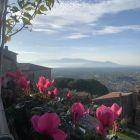The price of patriotism. By John Earle.
John Earles account of the Special Operations Executive (SOE) in the Balkans during world war two is a masterpiece of detached, investigative reporting. We only know Earle was actually there from the information on the book jacket and an off-hand phrase emphasising the need for practical talents in guerilla warfare. He quotes a British major approvingly: Guerilla warfare must be carried out in ones own district. This, on reflection, says Earle, sounds sensible enough. A successful guerilla must know the lie of the land. The present writer can confirm it. The partisan unit he was with in central Serbia had a strong leavening of idealistic young intellectuals from distant Belgradewho blundered about in forest and mountainside and were easily lost.
The SOE was a secret organisation set up in July 1940 after the fall of France to promote resistance in occupied Europe, to set Europe ablaze, to use Winston Churchills phrase. Earle says that its agents were described in terms later used for James Bond, but he goes on, deprecatingly, to explain that its tasks with the Yugoslav partisans were those of any military mission: ensuring supplies, coordinating intelligence and tactics, and so on.
Earle, who became a correspondent for Reuters after the war and then worked for The Times in Rome from the end of the 1960s to the mid-1980s, was recruited to SOE in north Africa in 1943, after being wounded at El Alamein. He was parachuted into Yugoslavia with the grade of captain, and subsequently headed missions in Serbia, Montenegro and Bosnia.
Much of his book is concerned with the rehabilitation of the reputation of the incredibly courageous padalci, or ethnic Slovene parachutists, whose contribution to the efforts of the Yugoslav army of national liberation was largely forgotten in the post-war tussles between Belgrade and Moscow.
Most of these partisans had been called up for service in the Italian forces and ended up on the front in the western desert in north Africa. There they were either taken prisoner or they deserted and volunteered with the British to work behind the lines in their home country. Many were infiltrated by sea, but the Slovene name padalci describes those dropped into the interior by parachute.
These small fry, as the British liaison officer at headquarters in Slovenia called them forgotten as they were by both sides in the war are now getting their just rewards, partly thanks to the publication in 1989 of a book by an ex-partisan, but mainly as a result of Slovenian independence in 1991. Now they are being remembered in plaques, memorials and tributes such as the following from the Slovene president: A symbolic apology of the Slovene state for past wrongs and as recognition to the parachutists of their courage and patriotism.
These Slovenes, recruited by, or who collaborated with the British, were (confusingly) given English cover-names: for example Zdravko Lenscak, to whom a whole chapter is dedicated in this book, was known as John Leonard. Lenscak was dropped into the upper Soca (Isonzo) river valley in July 1943 with two other padalci, Stanco Simcic and Ivo Bozic, who survived the war and its aftermath.
Lenscak was a somewhat ambiguous figure. He was the channel through which a loan was sent to the hard-up headquarters in Slovenia by the British intelligence service M16 to the disapproval of members of Marshall Titos staff, who thought that money from the west should not be accepted. He considered himself a cut above the other padalci and not entirely without reason, according to Earle. He was well educated and an excellent linguist. However, his real crime, according to the commander and the commissar of Slovenia headquarters, was that: He tries all the time, in spite of being a Slovene, to play the Englishman.
Certainly the English must have seemed deeply eccentric to the partisans, judging by the marvellous photographs in the book. One, captioned Target Practice, shows in Earles words: a group of people at IX Corps headquarters in the summer of 1944, one obviously British officer stands out, tall, seemingly a little stiff, wearing British army regulation shorts as issued in the Middle East the only person with bare knees.
Earles generosity towards foibles is attractive. One corporal, described laconically by his commander as unsatisfactory, and ordered not to return to headquarters, had according to Slovene eye-witnesses merely paid too much attention to wine and women after the fall of Gorizia. As Earle says: Was it not understandable, in a young man, after an enemy surrender?
But the aim of this book is a serious one: that of setting the record straight. As the author says: Historical events never look the same after half a centuryWhen participants die, they take with them a feeling for the spirit of the time that is lost to a new generation. The risk of revisionism is ever present. Earles main question is: Was Britain right in supporting the partisans? It looks as if it was. Earle produces evidence, in the form of a secret report written by an impartial observer for the British cabinet office in 1945/47, but only made public in 2000. The author of the report, William Mackenzie, writes: It appears that no other course was open to the British at the time when they decided finally to back Tito alone.
The author gives full credit to the prescience of British officers about future genocide in Yugoslvia once the Germans were gone. However, he takes side swipes at Pope Pius XII for avoiding coming out squarely on the side of democracy against nazi-facism, at the equivocal position of the Catholic Church in Croatia, and at the harsh nature of the Italian domination of Slovenia after world war one. His harshest criticism is reserved for those who betrayed their comrades in the name of now-deceased ideologies, such as Communism. Even the atrocities of the partisans secret police, the OZNA, have to be understood, he says. Given the spirit of the times, its activities, however reprehensible, were comprehensible.
The Price of Patriotism in an excellent read, full of gentle humour: its horrors recounted with restraint and detachment.
The Price of Patriotism, published by The Book Guild. For information contact Emma Whelan, emma@bookguild.co.uk.



















